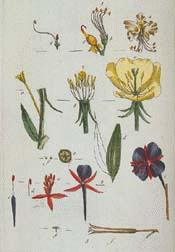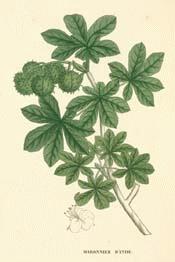
Botanical.com Home Page
Chestnut, HorseBotanical: Æsculus hippocastanum
---Synonym---Hippocastanum vulgare (Gaertn.).
|

|
(Aesculus hippocastanum) Click on graphic for larger image |
The name Aesculus (from esca, food) was applied originally to a species of oak, which according to Pliny, was highly prized for its acorns, but how it came to be transferred to the Horse Chestnut is very uncertain; perhaps, as Loudon suggests, it was given ironically, because its nuts bear a great resemblance, externally, to those of the Sweet Chestnut, but are unfit for food. Hippocastanum (the specific name of the common sort) is a translation of the common name, which was given - Evelyn tells us - 'from its curing horses brokenwinded and other cattle of coughs.' Some writers think that the prefix 'horse' is a corruption of the Welsh gwres, meaning hot, fierce, or pungent, e.g. 'Horse-chestnut' = the bitter chestnut, in opposition to the mild, sweet one.
The tree is chiefly grown for ornamental purposes, in towns and private gardens and in parks, and forms fine avenues, which in the spring, when the trees are in full bloom, present a beautiful sight.
---Description---The trunk of the tree is very erect and columnar, and grows very rapidly to a great height, with widely spreading branches. The bark is smooth and greyishgreen in colour: it has been used with some success in dyeing yellow. The wood, being soft and spongy, is of very little use for timber.
It is often used for packing-cases.
The sturdy, many-ribbed boughs and thick buds of the Horse Chestnut make it a conspicuous tree even in winter. The buds are protected with a sticky substance: defended by fourteen scales and gummed together, thus no frost or damp can harm the leaf and flower tucked safely away within each terminal bud, which develops with startling rapidity with the approach of the first warm days after the winter. The bud will sometimes develop the season's shoot in the course of three or four weeks. The unfolding of the bud is very rapid when the sun melts the resin that binds it so firmly together.
The large leaves are divided into five or seven leaflets, spreading like fingers from the palm of the hand and have their margins finely toothed. All over the small branches may be found the curious marks in the shape of minute horse-shoes, from which, perhaps, the tree gets its name. They are really the leaf scars. Wherever a bygone leaf has been, can be traced on the bark a perfect facsimile of a horse-shoe, even to the seven nail markings, which are perfectly distinct. And among the twigs may be found some with an odd resemblance to a horse's foot and fetlock.
The flowers are mostly white, with a reddish tinge, or marking, and grow in dense, erect spikes. There is also a dull red variety, and a less common yellow variety, which is a native of the southern United States, but is seldom seen here.
The fruit is a brown nut, with a very shining, polished skin, showing a dull, rough, pale-brown scar where it has been attached to the inside of the seed-vessel, a large green husk, protected with short spines, which splits into three valves when it falls to the ground and frees the nut.
[Top]
---Cultivation---The Horse Chestnut is generally raised from the nuts, which are collected in the autumn and sown in the early spring. The nuts should be preserved in sand during the winter, as they may become mouldy and rot. If steeped in water, they will germinate more quickly. They will grow 3 foot the first summer and require little care, being never injured by the cold of this climate. They thrive in most soils and situations, but do best in a good, sandy loam.
---Part Used Medicinally---The bark and the fruit, from both of which a fluid extract is made. The bark is stripped in the spring and dried in the sun, or by slight artificial heat, and when dry, occurs in commerce in flattened pieces, 4 to 5 inches long and about 1 to 1 1/2 inch broad-about 1 to 1 1/4 inch thick, greyish-brown externally, showing corky elongated warts, and on the inner surface pinkish-brown, finely striated longitudinally. The bark is odourless, but has a bitter astringent taste.
---Medicinal Action and Uses---The bark has tonic, narcotic and febrifuge properties and is used in intermittent fevers, given in an infusion of 1 OZ. to the pint, in tablespoonful doses, three or four times daily. As an external application to ulcers, this infusion has also been used with success.
The fruits have been employed in the treatment of rheumatism and neuralgia, and also in rectal complaints and for haemorrhoids.
---Preparations---Fluid extract, fruit, 5 to 20 drops. Fluid extract, bark, 1/2 to 2 drachms.
Horse Chestnuts as Fodder
In Eastern countries considerable use is made of Horse Chestnuts for feeding horses and cattle, and cattle are said to eat them with relish, though pigs will not touch them. The method of utilizing them is to first soak them in lime-water, which deprives them of the well-known bitter flavour inherent in the nuts, and then to grind them to a meal and mix them with the ordinary provender.
[Top]
---Constituents---Analysis has shown that the nuts contain 3.04 per cent. water; 2.66 per cent. ash; 10.99 crude protein; oil, 5.34 per cent.; and 73 97 per cent. carbohydrates. Experiments conducted at Wye College proved that the most satisfactory way to prepare the Horse Chestnuts as food for animals was to soak partly crushed nuts in cold water overnight, then boil them for half an hour or so and strain off the water. The nuts were then dried, partially husked and reduced to a meal, which, though slightly bitter, had a pleasant taste and appearance. The meal was fed to a calf, a sheep and two pigs. The calf received up to 5 lb. of the meal per day and made good increase in live weight, and the sheep suffered no ill effects, but the pig refused to eat the food containing the meal. It is concluded that Horse Chestnuts are not poisonous to any of the farm animals experimented with, within the limits of what they can be induced to eat, and that they form a highly nutritious food. Chestnut meal is a fairly concentrated food, and contains about 14 per cent of starch, it being calculated that 1 Ib. of Horse Chestnut meal would be equivalent to 1 Ib. 1 OZ. of feeding barley, 1 lb. 4 OZ. of oats, 1 lb. 8 oz. of bran, and 3 lb. 5 OZ. of good meadow hay.
Experiments made during the Great War proved that for every ton of Horse Chestnuts which are harvested, half a ton of grain can be saved for human consumption, and thus the Horse Chestnuts, though totally unfit for human food, can be utilized indirectly to increase the national food supply.
The genus Pavia is so closely allied as to be now generally grouped with the Aesculus. The Red Buckeye (Ae. pavia) is a handsome small tree with dense and large foliage, together with bright red flowers in large loose clusters in early summer. Sometimes it rises from 15 to 20 feet high, but some of its varieties are only low-spreading or trailing shrubs. The Yellow Buckeye (Ae. flava) is common and sometimes 40 feet high. It has somewhat the habit of the Red Horse Chestnut (Ae. rubicunda), but has smoother leaves. The DWARF HORSE CHESTNUT (Ae. parviflora) is a handsome shrub, 6 to 10 feet high, flowering in later summer. Its foliage is much like that of other Aesculi, and its small, white, fragrant flowers are in long, erect plume-flowers.
© Copyright Protected 1995-2025 Botanical.com
